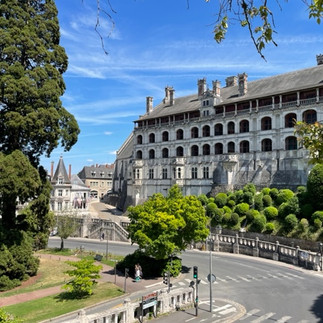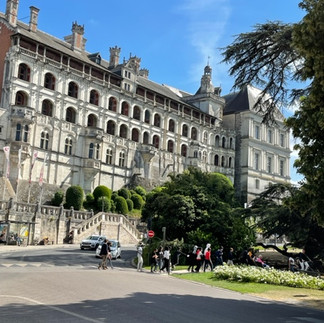We arrived in Blois and will explore the region by bicycle for the next few days. Blois has a history dating back to prehistoric times though it's most interesting period is probably the Renaissance (14th-16th centuries). It is listed as a World Heritage Site and it sits along both banks of the Loire River.
The building on the left has probably been here since the Middle Ages. The construction is called timber framing. There are many such buildings in the historic center. The town prides itself on a cultural heritage and these stairs and garden join the lower city to the upper one. Apparently the stairs are repainted from time to time with a different designs. Two stains on Blois's long history is a blood libel against the Jewish community in 1171 that resulted in at least 30 people were burned at the stake. In the 16th century Calvinists and Catholics had an intensive conflict during which many people were killed.

Bridges can tell a good story about a town, especially when the town spans both sides of the river. This is the main bridge across the Loire and the original Medieval bridge collapsed in 1617 and was rebuilt over the next 100 years. It was partially destroyed by the Germans in World War II along with a great deal of infrastructure in the town. The British destroyed more infrastructure when they liberated the town and the current bridge was repaired and dedicated in 1948.
The Chateau itself is the center of the town and where all the historical intrigue took place. It was the home of a number of French Kings. Charles VIII died with no heirs at the Chateau in Amboise (more on that later) and Duke Louis II had himself crowned Louis XII and established the monarchy in Blois since he was from there originally. He married Charles VIII's widow, Anne of Brittany in 1499. That cemented the ties between Brittany and France. They had a daughter Claude who married Francis I. Louis XII died and Francis I ascended to the throne. He is responsible for building another chateau (more on that later) but began moving the court to Fountainbleu closer to Paris. Other notable temporary residents were Joan of Arc who staged her offensive to recapture Orleans from here and Marie de Medici who sought refuge here after her son had her banished.

Inner courtyard of the Chateau. Construction began in the 13th century and continued through the 17th century. Of course, that means there are multiple different styles from Gothic to Renaissance. There are 564 rooms, 100 bedrooms, 75 staircases.

Porcupine emblem of King Louis XII. There are brass plaques imbedded in the streets of the town with this emblem to direct visitors in the direction of the chateau and others with a boat to direct visitors to the river. A lovely town to start our exploration of the Loire Valley.













Comments